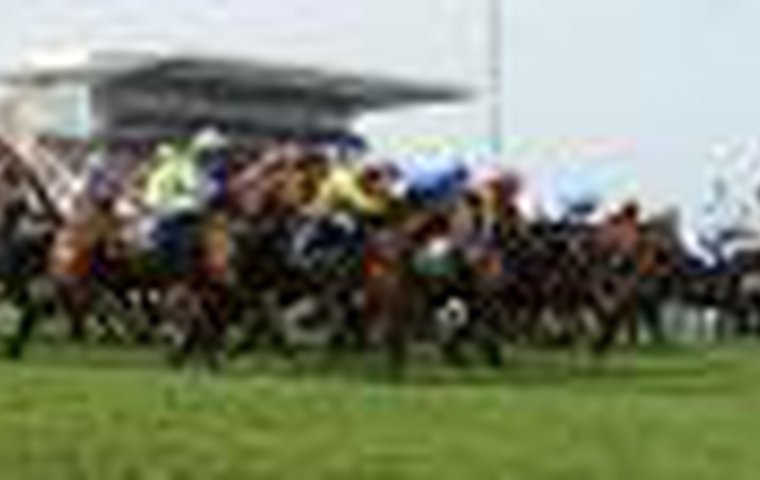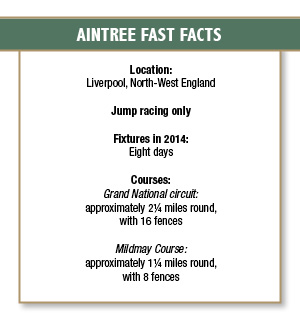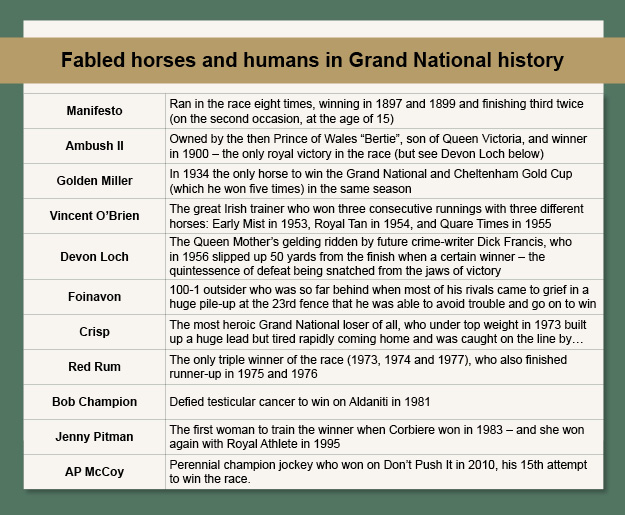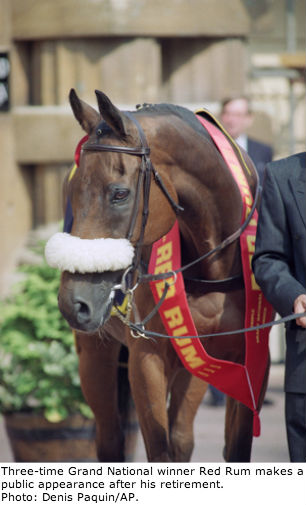
Aintree Racecourse Profile: The story of the Grand National
For lovers of racing, little compares to an afternoon (or evening) at the track. The sport is best experienced in the flesh, and the world’s race courses offer diverse ways to enjoy this pursuit. While we can’t literally transport you to the races, we’ll do our best to bring these tracks to you in a monthly series of profiles. Today, we begin a five-part look at Aintree Racecourse in England, home of this Saturday’s Grand National, the world’s most famous steeplechase. This is a unique racecourse, and not just because of the nature of the race that defines it. Sean Magee traces its history.
Read about Aintree's turbulent road to modern splendour
Read about the Grand National's notorious fences
Read about Aintree's star-studded racing programme
Read about the one and only Aintree experience
----------
There are many famous courses
In the width of English ground
Where the steeplechasing horses
And the rainbow silks go round.
But it’s Aintree, Aintree, Aintree
Where the champion chasers run,
Where there’s courage to be tested
And there’s glory to be won.
- Will H. Ogilvie (1869-1963)
Aintree, home of the Grand National, is the best-known jumping racecourse in the world. Indeed, it is so familiar, even to those with no interest in horseracing, that its most famous obstacle, Becher’s Brook, has entered the English language as a metaphor for a dangerous barrier to be crossed. 
Becher’s Brook is not the only Aintree landmark that resonates beyond the confines of the sport: the Melling Road, Valentine’s Brook, the Chair fence, the Foinavon fence, and the Elbow all form part of Aintree’s special vocabulary.
Yet, for all its familiarity and the excitement the Grand National produces every year, Aintree remains a course of contradictions. For one thing, the greatest challenge in the once-rural sport of steeplechasing takes place in an unprepossessing suburb at the edge of the vast urban sprawl of Liverpool. For another, an event that routinely produces widespread admiration for the equine and human participants, it also produces condemnation from those who consider the risks to horses too great.
The Grand National has a long, vibrant, and often sensational – occasionally farcical – history. Yet, the three-day National meeting is the epitome of the modern racing occasion in Britain, with best-turned-out-lady competitions, a team of stylists on hand to help racegoers with fashion emergencies, and all manner of other sideshows – an experience fuelled by a prodigious intake of alcohol.
Nor is controversy ever very far from the Grand National, for the race billed as “The Original Extreme Sport” attracts a great deal of hostility from animal welfare activists. Understandably, that hostility spikes dramatically when horses are irreparably damaged, as was the case in 2012, when one of two casualties was that season’s Cheltenham Gold Cup winner Synchronised.
None the less, a racecourse that long lived under threat of closure has in recent years enjoyed a vibrant new lease of life, with the tired and dingy old stands being replaced by superb modern facilities. And the Grand National itself, for too long run in a downbeat, gloomy atmosphere, is now the sparkling centrepiece of one of the planet’s great racing occasions.
HISTORY
The history of Aintree Racecourse is essentially the history of the Grand National.
Organised horseracing took place in the Liverpool area as long ago as the 16th century. But, the modern history of the racecourse begins with a Liverpool hotel owner named William Lynn, who in 1829, instigated flat racing on land at Aintree he had leased from the Earl of Sefton. In 1835, Lynn staged a hurdles meeting (hurdles being smaller obstacles than steeplechase fences) on the same land, and then had the idea of staging a Lancashire race to rival the Great St. Albans Steeplechase, first run in 1830 – and the Liverpool Grand Steeplechase was first run in February 1836.
There has been considerable scholarly debate over recent decades concerning which year this most famous of British horse races began. The old school liked to place the inaugural running in 1839 – the fact that the National was won by a horse named Lottery that year was irresistibly appealing – with its forebears being staged in the nearby village of Maghull. But research by John Pinfold, the most rational as well as most diligent chronicler of the race’s history, has shown that the race was first run on its present site – and over a circuit shaped much like the modern version – in 1836, when Captain Martin Becher rode The Duke to victory. The Duke won again in 1837, this time ridden by a Mr. Potts. The following year the winner was a horse called Sir William.
The 1839 running, named “The Grand Liverpool Steeplechase,” was advertised as being “four miles across country” – though starting and finishing on the established racecourse – and the conditions include the stipulation: “No rider to open a gate or ride through a gateway, or more than 100 yards along any road, footpath or driftway.” There were 29 obstacles, including a five-foot high stone wall and, about a mile from the stand at the far end of the circuit, a “strong paling, next a rough, high jagged hedge, and lastly a brook about six feet wide.”
As the 1839 field came toward that “strong paling,” Captain Becher led the field on Conrad, who hit the obstacle hard and propelled his rider into the brook, from where – as legend has it – a drenched Becher emerged with the declaration that “water is no damned use without brandy!” Whether or not that detail has any credence, the devil-may-care Becher remounted Conrad and went in pursuit of his rivals, only to suffer another dunking at the next brook.
The Grand National – and thus Aintree Racecourse – grew in popularity throughout the second half of the 19th century. By the early 20th century, it was towering above all other steeplechases in the calendar, a position it held until threatened after World War II by the growing prestige of the Cheltenham Gold Cup. Although the Gold Cup is now considered the elite race, it has nothing like the National’s grip on the imagination: given the decline of the Derby in public esteem, the Grand National is the nearest that British horseracing has to “The Race that Stops the Nation,” with an estimated global television audience of 600 million (9 million in Great Britain), and some £500 million ($834 million) annually wagered on the race in the UK, a large proportion of it from once-a-year punters.

The racecourse has two permanent reminders of Red Rum’s unique feat of winning three Grand Nationals: The grave of this famous horse is at the winning post, and a magnificent Philip Blacker bronze of Red Rum graces the lawn behind the stands.
 On a less celebratory note, recent years have seen two of the most extraordinary Grand National occasions:
On a less celebratory note, recent years have seen two of the most extraordinary Grand National occasions:
- In 1993, the race was declared void after two false starts had caused mayhem;
- In 1997, a few days before the UK general election, racing was abandoned and the racecourse evacuated following an IRA-sourced bomb threat; the race was run on the Monday, two days later than planned.
Perversely, calamitous events such as those add to rather than diminish the appeal of the Grand National. And while some diehards feel that the soul has gone out of the race following the introduction of various safety measures, they are in the minority. To most observers, the Grand National remains a race like no other – and for 10 minutes every April, Aintree Racecourse becomes the centre of the sporting world.
---
Tomorrow: Aintree’s incredible journey to modern splendour
Read about Aintree's turbulent road to modern splendour
Read about the Grand National's notorious fences


